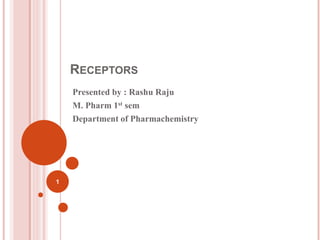Receptors seminar.pptx
A receptor is a protein molecule usually found embedded within the plasma membrane surface of a cell that receives chemical signals from outside the cell and when such chemical signals bind to a receptor, they cause some form of cellular/tissue response. Receptor is a macromolecule whose function is to recognize and respond to chemical signal There are 3 types of receptors. Those are: i. Internal /Intracellular/Cytoplasmic receptors: found in the cytoplasm of the cell respond to hydrophobic ligand molecules ii. Cell-surface / transmembrane receptors/ cell specific proteins performs signal transduction, converting an extracellular signal into an intracellular signal. iii. Nuclear receptor Located in the nucleus of the cell i. Internal /Intracellular/Cytoplasmic receptors Steriod receptor ii. Cell-surface / transmembrane receptors/ cell specific proteins G-protein- coupled receptor Enzyme- linked receptor/ tyrosin kinase receptor Ion channel- linked receptor/ ligand gated receptor iii. Nuclear receptor Thyroid receptor

Recommended
Recommended
More Related Content
What's hot
What's hot (20)
Similar to Receptors seminar.pptx
Similar to Receptors seminar.pptx (20)
Recently uploaded
Recently uploaded (20)
Receptors seminar.pptx
- 1. RECEPTORS Presented by : Rashu Raju M. Pharm 1st sem Department of Pharmachemistry 1
- 2. CONTENTS Definition Classification and description of each class. Description of individual receptor. Forces affecting the drug receptor binding. Agonist and antagonist 2
- 3. RECEPTOR A receptor is a protein molecule usually found embedded within the plasma membrane surface of a cell that receives chemical signals from outside the cell and when such chemical signals bind to a receptor, they cause some form of cellular/tissue response. Receptor is a macromolecule whose function is to recognize and respond to chemical signal. 3
- 4. CLASSIFICATION There are 3 types of receptors. Those are: i. Internal /Intracellular/Cytoplasmic receptors: found in the cytoplasm of the cell respond to hydrophobic ligand molecules ii. Cell-surface / transmembrane receptors/ cell specific proteins performs signal transduction, converting an extracellular signal into an intracellular signal. iii. Nuclear receptor Located in the nucleus of the cell 4
- 5. i. Internal /Intracellular/Cytoplasmic receptors Steriod receptor ii. Cell-surface / transmembrane receptors/ cell specific proteins G-protein- coupled receptor Enzyme- linked receptor/ tyrosin kinase receptor Ion channel- linked receptor/ ligand gated receptor iii. Nuclear receptor Thyroid receptor 5
- 6. 3 main components of receptor: i. an external ligand-binding domain (extracellular domain), ii. a hydrophobic membrane-spanning region, iii. and an intracellular domain inside the cell. 6
- 7. G-PROTEIN LINKED OR COUPLED RECEPTORS Binds with a ligand and activate a membrane protein called a G- protein. The activated G-protein then interacts with either an ion channel or an enzyme in the membrane. Each receptor has its own specific extracellular domain and G- protein-binding site. 7
- 8. MECHANISM 8
- 9. FAMILIES OF GPCR 3 families A- Rhodopsin family. E.g. Amine, purine, cannabinoids B- secretin/glucagon receptor family E.g Peptide hormone C- metabotropic glutamate receptor/calcium sensor family. E.g. GABAB, glutamate 9
- 12. ENZYME-LINKED RECEPTORS Cell surface receptors with intracellular domains that are associated with an enzyme. Normally have large extracellular and intracellular domains. When a ligand binds to the extracellular domain, a signal is transferred through the membrane and activates the enzyme, which eventually leads to a response. Example : Tyrosine Kinase receptor 12
- 13. STRUCTURE OF KINASE RECEPTOR 13
- 14. TYPES Receptor tryosine kinase e.g. insulin receptor Serine/ threonine kinases e.g. TGF Cytokine receptor e.g. cytokinin Guanylyl cyclase receptors e.g. ANP 14
- 15. 15
- 16. ION CHANNEL-LINKED RECEPTORS Receptors bind with ligand. (Ex:Nicotinic Receptor) Open a channel through the membrane that allows specific ions to pass through. Conformational change in the protein's structure that allows ions such as Na,Ca, Mg, and H2 to pass through. 16
- 18. STRUCTURE 18
- 19. MECHANISM 19
- 20. CONTD.. Due to concentration changes of different ions the following effects can be seen. 20
- 21. NUCLEAR RECEPTOR Ligand activated transcription factors. Present in soluble form- either in cytoplasm or nucleus- freely diffusible. Transduce signals by- modifying gene transcription. E.g. steroid hormones, glucocorticoids, vit.D and A, orphan receptors. Play vital role in endocrine signalling and metabolic regulation. 21
- 22. 22
- 23. 23
- 24. FORCES AFFECTING THE BINDING 3 major types of chemical forces/bonds. Those are : Covalent, Electrostatic & Hydrophobic interaction. 1. Covalent bond : very strong "irreversible" under biological conditions. extremely stable. Example : It is formed between the activated form of Phenoxybenzamine and the α-adrenergic-receptor. 24
- 25. FORCES AFFECTING THE BINDING 2. Electrostatic bond : Very common & weaker than covalent. Interaction strength is variable Example : van-der Waals forces. 3. Hydrophobic interactions : Generally weak, but important. Significant in driving interactions. Lipophilic drugs and the lipid component of biological membranes. 25
- 26. AGONIST AND ANTAGONIST Agonist : Agonists are chemical that binds to a receptor of a cell and triggers a response by that cell. Antagonist : Antagonists are drugs that decrease the actions of another drug or endogenous ligand. 26